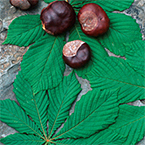Horse Chestnut

On this page:
Introduction
This fact sheet provides basic information about horse chestnut—common names, what the science says, potential side effects and cautions, and resources for more information.
Horse chestnut trees are native to the Balkan Peninsula (for example, Greece and Bulgaria), but grow throughout the Northern Hemisphere. Although horse chestnut is sometimes called buckeye, it should not be confused with the Ohio or California buckeye trees, which are related but not the same species.
For centuries, horse chestnut seeds, leaves, bark, and flowers were used for a variety of conditions and diseases. Today, horse chestnut seed extract is used primarily as a folk or traditional remedy for chronic venous insufficiency (a condition in which the veins do not efficiently return blood from the legs to the heart). This condition is associated with varicose veins, pain, ankle swelling, feelings of heaviness, itching, and nighttime leg cramping. The seed extract has also been used as a folk or traditional remedy for hemorrhoids.
Horse chestnut seed extract standardized to contain 16 to 20 percent aescin (escin), the active ingredient, is the most commonly used form. Topical preparations have also been used.
What the Science Says
- Studies have found that horse chestnut seed extract is beneficial in treating chronic venous insufficiency. There is also preliminary evidence that horse chestnut seed extract may be as effective as wearing compression stockings.
- There is not enough scientific evidence to support the use of horse chestnut seed, leaf, or bark for any other conditions.
Side Effects and Cautions
- Do not use raw or unprocessed horse chestnut seeds, leaves, bark, or flowers. They contain esculin, which is poisonous.
- When properly processed, horse chestnut seed extract contains little or no esculin and is considered generally safe when used for short periods of time. However, the extract can cause some side effects, including itching, nausea, or gastrointestinal upset.
- Tell all your health care providers about any complementary health practices you use. Give them a full picture of what you do to manage your health. This will help ensure coordinated and safe care. For tips about talking with your health care providers about complementary and alternative medicine, see NCCAM's Time to Talk campaign.
Sources
- Horse chestnut. Natural Medicines Comprehensive Database Web site. Accessed at www.naturaldatabase.com on September 8, 2009.
- Horse chestnut. Natural Standard Database Web site. Accessed at www.naturalstandard.com on September 8, 2009.
- Horse chestnut seed extract. In: Blumenthal M, Goldberg A, Brinckman J, eds. Herbal Medicine Expanded Commission E Monographs. Newton, MA: Lippincott Williams & Wilkins; 2000:201–204.
For More Information
NCCAM Clearinghouse
The NCCAM Clearinghouse provides information on NCCAM and complementary health approaches, including publications and searches of Federal databases of scientific and medical literature. The Clearinghouse does not provide medical advice, treatment recommendations, or referrals to practitioners.
PubMed®
A service of the National Library of Medicine (NLM), PubMed® contains publication information and (in most cases) brief summaries of articles from scientific and medical journals.
Office of Dietary Supplements (ODS), National Institutes of Health (NIH)
ODS seeks to strengthen knowledge and understanding of dietary supplements by evaluating scientific information, supporting research, sharing research results, and educating the public. Its resources include publications (such as Dietary Supplements: What You Need to Know), fact sheets on a variety of specific supplement ingredients and products (such as vitamin D and multivitamin/mineral supplements), and the PubMed® Dietary Supplement Subset.
NIH National Library of Medicine's MedlinePlus
This publication is not copyrighted and is in the public domain. Duplication is encouraged.
* Note: PDF files require a viewer such as the free Adobe Reader.
